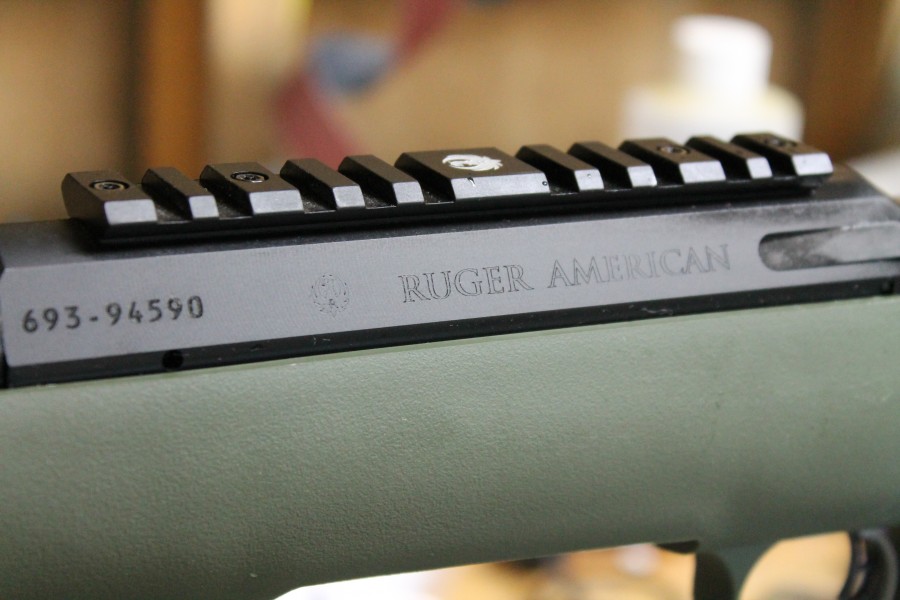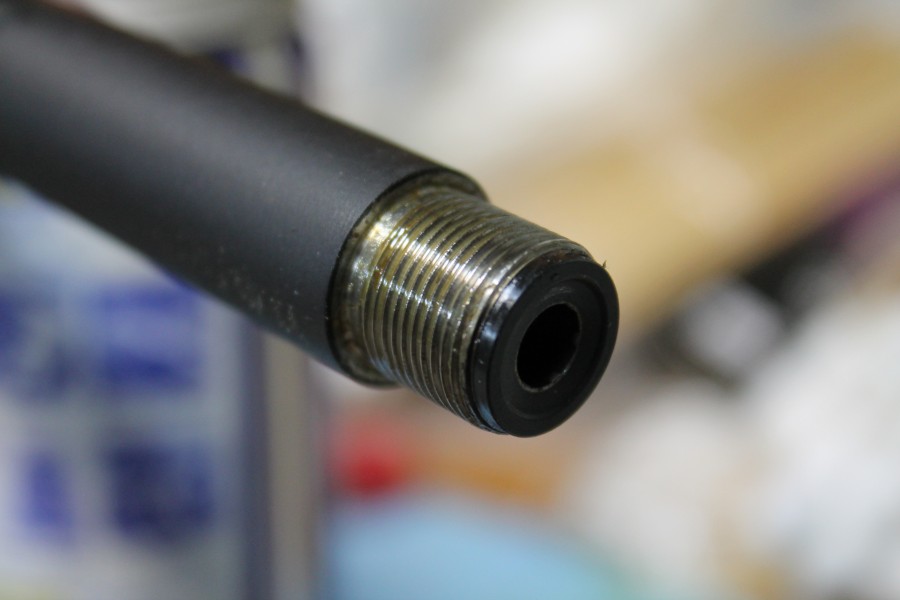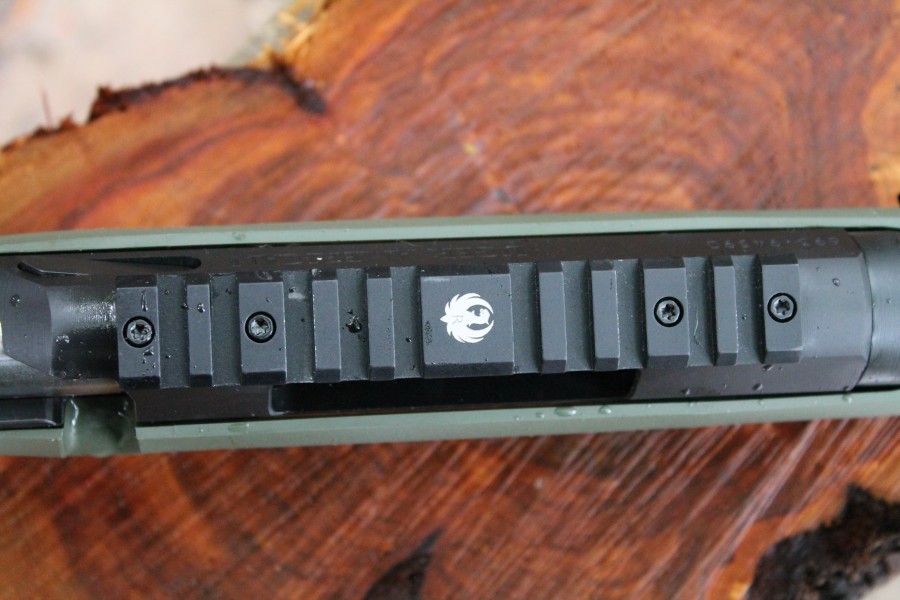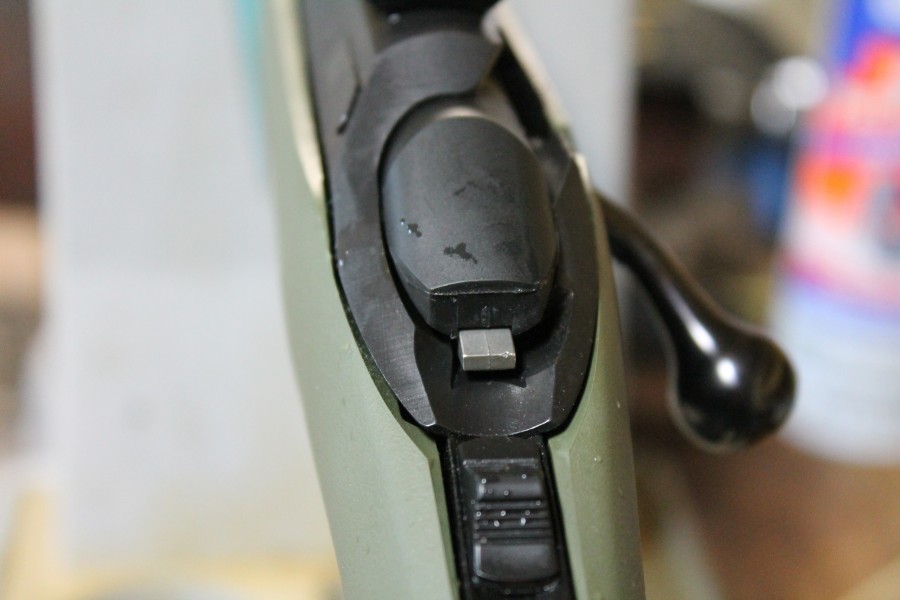It might be a rainy day here in Austin, Texas but the gun gods are smiling upon us, as my FFL has called to inform me that a shiny new Ruger American Rifle arrived this week. The American Rifle series is Ruger’s budget-minded answer to the a market that demands performance at a rock-bottom price. The new Predator edition aims to add some “nice to haves” to the bargain priced rifles that Nick reviewed, and liked a great deal . . .

Those “nice to haves” over the base model Ruger American Rifle include the moss green stock, a Picatinny rail, and a threaded barrel. All that for an extra $40 over the standard model. The Predator edition still retains the Power Bedding Block in the stock, the adjustable trigger, and the short throw bolt. But the biggest difference has to be in the chamber.
Where the American Rifle comes in your fairly standard calibers (22-250, .223 REM, .243 WIN, .270 WIN, 7mm-08, .30-06, and .308 WIN), the Predator series drops .270 WIN and .30-06 in favor of .204 Ruger and 6.5 Creedmoor. Our test rifle is chambered in 6.5 Creedmoor which is a darling of a cartridge. The 6.5 bullets are slicker than goose droppings and fly well out past the 1000 yard line. That’s important for those folks looking to put a little distance between themselves and the target.
I haven’t personally shot a 6.5 Creedmoor gun yet, but I did run a very (ballistically) similar .260 Remington at the Bushnell Brawl and I was floored by how well it bucked the wind down in south Texas.
We’ve stocked up on four different types of factory ammo to see what the Predator likes shooting best. You’ll see a distinct bias towards Hornady offerings and that’s strictly because Hornady has such good factory support for this cartridge. I’ve picked the 120 gr and 140 gr. A-MAX as well as the 120 gr. all-copper GMX from the Hornady lineup. At this time the SST offering is backordered. I also picked up two boxes of Winchester’s Match offering running a 140 gr. BTHP that I suspect is a Sierra.
I mentioned earlier that the Predator comes from the factory with a threaded barrel. This should make those with heavy investments in silencers very happy along with folks who might want to put a brake on the front to tame the 6.5’s recoil. The threading appears to be uniform and clean, and my guess is that our review won’t identify any problems with it. But we shall see.
One problem I’ve already identified is the Picatinny rail used for mounting optics. Bushnell has been kind enough to give us a long-term loan of a HDMR 3.5-21X scope for accuracy testing. The burly Bushnell comes equipped with a big 34mm tube and a 50 mm objective. That makes mounting that scope a bit tough, but Warne was nice enough to send us a one-piece mount that gives enough clearance for most guns.
Keen observers will notice in the photo above that the Predator does not have uniform spacing between the slots on the rail. This means that one-piece scope mounts are a no-go. Trust me, I tried three different types.
Until I’m able to find a two-piece set of rings with enough clearance for that big 50 mm objective, our test is on hold. I can tell you now that Ruger is going to lose stars for their poor execution on this feature.
One other item that’s going to detract from the overall review is, you guessed it, stock comb height. Even though this rifle ships without iron sights, and with a rail meant for mounting a scope, the comb on the stock still drops to the same level that an iron sight-equipped rifle would. This means that getting a solid cheek weld with an optic, especially one with a large objective, will be nearly impossible. The ultimate result from this design decision is a degradation in practical accuracy vs. a rifle with a properly equipped stock. We’ll see how it plays out in real world testing.
The last nit that needs picking is the overall finish on the gun. I realize that this is a budget gun, and as such, if it shoots well, I’m turning a blind eye to the very obvious machining marks that are evident. The entire gun is covered in various cutting marks from the tooling pieces that transform this from a forgingcasting to a shootable rifle. Again, at this price point, I can’t expect perfection, so if it shoots well, I’ll look the other way. With that out of the way, here’s some good stuff.
The trigger is really, really good. It’s one of the better factory rifle triggers I’ve used, and ranks right up there with Savage’s AccuTrigger for feel. There’s no takeup, no grit, no nothing. Just a wall, and a clean break with touch of over travel. Out of the box, it registered a consistent four pounds and an ounce on my trigger scale. Once I find my American Allen wrenches, I’ll pop it out of the stock and adjust it down to see what the lower limit is. Oh that’s right, it’s totally adjustable. Score one for Ruger!
Further proof that this is a “functional” gun before a pretty one is evidenced by the completely free-floated, albeit flimsy polymer stock. I’ve heard good things about the Power Bedding System, so I expect that this will contribute to overall accuracy quite a bit. Ruger also seems to have gone back to putting the safety where the M77 MK I had it, and I think it works better than the throw lever that my M77 MK II has. The bolt also seems to be a bit smoother than my MK II, and I’ve had no issues cycling it quickly. We’ll see how it does with live ammo.
On that note, the ammo is stored in a compact rotary magazine made of plastic. Ruger is well-known for their rotary 10/22 magazines, and I have reason to think that the design of these will mean no feeding and extraction issues.
Now we sit and wait on a set of rings to arrive in the mail. Once they’re here, I can start shooting it to see if the compromises in finish were a trade off for stellar accuracy.










Tyler, the pic rail looks as though it’s screwed on, can it be changed out in favor of a true 1913 rail?
I really dig the Creedmore round. Looking forward to this review.
I thought the same thing, but I think that kind of defeats some of the appeal of the gun, if you have to replace one of its selling points.
Me, too, Tom. I’m now a fan of the .264 bullet. 6.5 Grendel has made a believer out of me.
Ken Ferrell makes awesome quad rail mounts. I’ve got one on my Savage 110 BA .338 Lapua with a 20 MOA cant. The original tri-rail that came with the gun didn’t have true 1913 rail spacing. It’s garbage. A lot of gun manufacturers make crappy accessories. Looks like Ruger went the same route with this rail. Shame.
The U.S. Optics rail mount is another really good one. Not sure which manufacturers are offering upgrades to the Ruger American.
Huge fan of the 6.5Creedmore and reload it extensively. It really shines in the 140gr range. My next AR is being built in this caliber. Let me know if there is a bullet you want to try and I’ll build up a short ladder for you. Odds are I have the bullet.
IMHO, I bought one after a 40 year layoff from hunting, the Ruger American is the best bang for the buck in budget hunting rifles out there. I have the .243 and with a cheap, under 200 buck, redfield 3x9x40 this rifle does everything I need it to.
I’ve only fired it to 300 yards but it performed as expected. And that rotary mag works as well, maybe better than the 10-22 mags. The .243 is a rimless round and rimless rounds do better in mags than rimmed rounds.’
Barring some major factory glitch I figure you’ll be pleased by this varient.
I have an American in .243. It had to be sent back because it wouldn’t chamber any factory rounds without really applying pressure to the bolt handle, which just doesn’t cut it. No other complaints though, it shoots very well and the trigger is great. No worrying about beating it up a little, it wasn’t really pretty to begin with. For the money, it can’t be beat.
Did we forget to mention the price?
There’s one on gunbroker right now sitting at $415. And the reserve has been met.
I bought one in .308 through gunsamerica.com a week ago for $429 shipped.
I’ve noticed 6.5 and 6.8 calibers are on the rise but anyone have any experience yet with the .277 Wolverine?
I have a soft spot for Ruger rifles…
Specifically, the M77 and 10/22, I doubt the American would be any different.
I’ve called Ruger twice for replacement parts on my 70’s era, pawn shop purchased M77 and customer service shipped me the parts totally FOC.
Ruger rifles are THE working man’s rifle, IMHO.
Question about the cartridge: 6.5 Creedmore sounds fairly similar to basic old school .270. Similar bullet weights and velocity.
Why the interest in the 6.5? Is it just the fact that it is a short action, based on a .308 case rather than a long action based on a 30-06 case? Sorry for my ignorance. I was just wondering.
I just shot my first bolt-action gun today in 7mm-08 with Hornady Superperformance 139 SST, and the first shot recoil was more than just a “hello, nice to meet you”. Coming from an AR 223-Wylde, it was like going from beer to vodka, and I’ve got a new appreciation for people that can shoot a 30.06, mag calibers, and the TRex. Tyler’s 6.5 Creed, with the 140 AMax, would better my ballistics and have less recoil also.
You may want to look at .243 Winchester.
7mm-08 is one of the lighter-recoiling big game rounds out there. It is one that I recommend to women who are recoil shy who want to get into deer & elk hunting. A very capable round, the 7-08.
A .30-06 isn’t what I think of as objectionable recoil. A typical .30-06 round (150+ grains) in a typical rifle (8+ lbs) gives you about 17+ ft-lbs of recoil. I tend to think of recoil more than 25 to 35 ft-lbs as being objectionable, unless the rifle doesn’t fit and you’re prone. A .338 WinMag in a 8 lb. rifle will give you about 33 ft-lbs of recoil, and it’s a snappy recoil impulse, one of the more objectionable ones out there. That’s where I think recoil starts becoming objectionable.
From what I understand, there’s not a dramatic difference between 7mm-08 and 6.5 Creedmoor in performance. Recoil will be a little less in 6.5, ammo may cost a little less. But external ballistics? While the 6.5s are the hot thing right now, the 7mm-08 actually has higher BC loadings available. I don’t have enough experience or access to reliable, corroborated data to declare one a victor in external ballistics, but I think the difference is negligible for practical purposes. One area where the 7mm-08 is universally agreed to be superior to the 6.5 Creedmoor is in terminal ballistics. It’s a more effective round on game (and presumably on man). For target shooting or competition, I’d go with the 6.5mm Creedmoor (or .260 Remington). But I want my rifles to be practical for killing first and foremost. So I prefer 7mm-08, because recoil is close, it’s hard to tell which round is more conducive to accuracy, and it hits harder. I agree with Indiana Tom, if you can’t get used to 7mm-08 recoil and shoot well with it (which almost all shooters are capable of with practice, as pointed out by Dyspeptic Gunsmith), then you should consider the very light-recoiling .243 Winchester. But if you’re hunting deer with it you should shoot within moderate ranges, choose a highly effective well-designed bullet, and probably consider something else for the largest species. But .243 is capable of getting the job done and is an accurate round. If you handload the really heavy (and honestly rather boutique) high-BC VLD rounds (over 100gr) which won’t work in most semi-autos, you can get external ballistic performance on par with 6.5 Creedmoor or any other .308 Winchester-based cartridge. Read about the accuracy potential of .243 Winchester here, including information on the 115gr DTAC bullets with which the .243 can best much more powerful 6.5mm cartridges.
I actually bought the Remington 788 in .243 Winchester as more of a varmint rifle for out at the farms as at that time (1980), Indiana did not allow high powered rifles for deer, but you can use .300 Winchester Mag for squirrel which are in trees.Go figure. It is a fair rifle for what I use it for, and it could take down a deer rather well. Recoil is mild. The .243 has a rather flat trajectory, it is very accurate and groups very well. I have an old Weaver V9 scope which still works rather well for my purposes.
http://snipershide.scout.com/story/1496625-hello-2015-now-replace-your-308
tl;dr better balistic values, more energy down range after 200y or so, cheaper bullets for reloading, less recoil.
It DOES NOT have a Picatinny rail; standards are standards.
Call it a Weaver rail if you wish.
Yep. There’s Mil-STD 1913, and then there’s a bunch of crap that doesn’t work.
I have a Ruger American Predator in .308 I have had no such trouble mounting an optic to it. As opposed to a large 50mm objective I chose a 2-7 Nikon with a 32mm Objective with low mounts. I have no trouble with my cheek weld; this also keeps the rifle light and handy, which I think is more of the intended purpose for this gun, not a 1000 yard bench gun.
Either way this is an Awesome Gun.
I have the Ruger American Predator in 6.5 Creedmoor. Bought it off Buds for $370. When I got it, she had the standard Ruger American scope mounts, not the rail. Called Ruger and got the rail a week later. That plastic stock is trash. I could literally see my heartbeat in the scope as it translated through the stock. No problem. Boyd’s makes a stock for $110. Comb height was an issue with the OEM stock. Ruger used to have a mail in rebate offer for a buttstock bag/riser. I have it on the Boyd’s now. Medium rings with the Primary Arms 4-14 FFP Mil/Mil scope ($250) make for a perfect sight picture. To date 60 rounds of Hornady Match even split between 120gr A-max and 140gr A-max. No problems. All 60 fed, fired, and ejected. I ordered another 100 rounds of 120gr. Price shipped was $150 (ammoseek). Most importantly is accuracy. I did a 5 shot group at 300 yards for a 2 3/4 inch group. More importantly my 14 year old son put 6 shots in an inch at 100 yards the first time he shot the rifle. Not bad for less than $750 dollars total investment. I don’t have anywhere to shoot past 300 yards, so I can’t speak to longer range accuracy. I highly recommend this rifle.
Most of Ruger’s parts (other than barrels) tend to be cast, not forged. I can’t speak to this rifle’s receiver or bolt.
The splotches on the cocking piece in your picture where you reference the finish appear to be splatters of their spray-on/bake-on finish, not machining marks.
I think those splotches are just water. It appears it was lightly raining when the photos were taken.
My mistake. They’re cast and I updated it.
I bought a RAR in 308 at a gun show for $300 out the door. I printed a sub 1/2″ group with it and a 150grain handload. Harvested several deer with it this last season. My gun has tool marks as well. It is a great light weight hunting rifle with unbelievable accuracy for the price. Will be interesting to see if the 6.5 Creed is as accurate or if it really can be shot accurately to 1000yds.
Comments are closed.